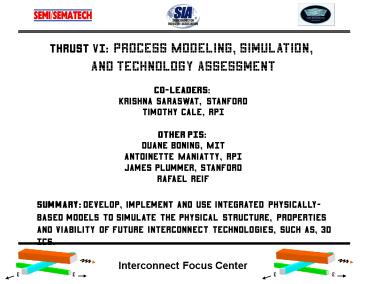Thrust VI: Process Modeling, Simulation, PowerPoint PPT Presentation
1 / 10
Title: Thrust VI: Process Modeling, Simulation,
1
Thrust VI Process Modeling, Simulation, and
Technology Assessment Co-leaders Krishna
Saraswat, Stanford Timothy Cale, RPI Other PIs
Duane Boning, MIT Antoinette Maniatty, RPI James
Plummer, Stanford Rafael Reif
Summary Develop, implement and use integrated
physically-based models to simulate the physical
structure, properties and viability of future
interconnect technologies, such as, 3D ICs.
2
- Approaches
- Create a spectrum of physically based models
- atomic-level understanding of materials and
structures - ...
- macroscopic (across-chip) modeling of spatial
variations - Link process models to, higher level simulation
tools - Assess new technology and compare trade-offs in
performance, manufacturability, and reliability
- Objectives
- Models to predict realistic structures and
physical and electrical properties based on the
fabrication process - Assessment of new interconnect technologies using
simulation and test structures
3
Research Tasks
- Develop process models and test structures to
predict physical and electrical properties. - Atomic and mesoscopic level physically based
models (RPI Stanford) - Spatial geometry and parameter variations at long
length scales (MIT) - Develop methodology for integrated assessment of
interconnect technologies - Link process models to higher level simulation
tools tradeoffs between performance and
reliability (Stanford, MIT) - Statistical interconnect design methodology
-tradeoffs between variation and performance
(MIT) - Assess new interconnect technologies
- Analysis of alternative interconnects (e.g., air
gaps, 3D ICs) (Stanford, MIT) - Analysis of alternative robust clocking schemes
(MIT)
4
Back-End Simulation Methodology
5
Air-Gap Interconnect Structures Performance and
Reliability
- Motivation
- Interconnect RC delay, crosstalk, noise, CV2f
power all limit IC performance. - Air-gaps reduce capacitance but may cause
reliability process integration problems.
- Approach
- Characterize air-gap formation and performance
using test structures. - Use SPEEDIE to simulate depositions and identify
deposition mechanisms. - Use results to simulate interconnect performance,
reliability, and manufacturability.
6
Effects of deposition conditions on feature scale
spatial variation of properties of as deposited
thin films in interconnect structures
- Motivation
- Because of spatial variations in deposition
parameters and topography, properties of
interconnect structures such as grain structure,
density, etc. vary with position. - Spatial variations can cause performance and
reliability problems.
Discrete model
Continuum model
- Approach
- Develop discrete models for the formation of
microstructure. - Develop granular continuum models to predict
topography and composition. - Develop models to predict spatial variation of
physical and electrical properties as a function
of deposition conditions and topography. - Integrate with higher level models.
7
Modeling of Physical Properties of Interconnects
during Thermal Cycling
- Motivation
- Microstructure and mechanical behavior can change
during processing and thermal cycling. - Void/hillock formation, grain growth, and
dislocation glide/climb can occur. - These changes can affect performance and
reliability of interconnects.
Stress distribution in Al from cooling
- Approach
- Characterize mechanical behavior and
microstructure in backend structures during
processing - Develop models and parameters to predict
mechanical behavior given initial microstructure - Integrate with other models and use for
performance and reliability assessment.
8
Modeling of Physical Phenomena in Polycrystalline
Structures
- Motivation
- Interconnect materials are non-homogeneous, with
grains and grain boundaries (GB). - In current interconnects, grain size approaches
feature size - Variability in GB properties leads to variability
in interconnect performance - Technologically relevant problems (e.g. hillocks,
electromigration, resistivity) involve coupled
diffusion, stress, boundary movement, thermal
effects and electric field.
- Approach
- Build test structures to determine grain/grain
boundary effects. - Formulate the system of equations governing
coupled stress/diffusion from thermodynamic
considerations. - Develop solution methods to capture effects of
local variations in properties. - Simulate real structures to assess performance
and reliability of advanced interconnects.
9
Statistical Modeling of Interconnect Variation
- Statistical interconnect design methodology is
not well understood - Inherently non- local e. g. critical paths
- Characterization and assessment of impact of
random and systematic variation is needed
Effect on Delay of Global Paths
Spatial Variation Process Models
Layout Information
IBM 1 GHzProcessor
Mehrotra et al., IEDM 98
- Modeling
- Characterization via experimental test
structures - Coupling to technology - Assess new material,
fabrication options - Coupling to design
- Understand impact of variation
- Optimize interconnect approaches
- Asses alternative interconnect technologies
10
3D ICs with Multiple Active Si Layers
Interconnect Delay
- Motivation
- Performance of ICs is limited due to R, L, C of
interconnects - Interconnect length and therefore R, L, C can be
minimized by stacking active Si layers - Number of horizontal interconnects can be
minimized by using vertical interconnects - TFT repeaters could be fabricated on top of a
metal line
- Approach
- Compare the tradeoffs in performance,
reliability and manufacturability of various
approaches to 3D SOI through simulation and
building test structures - Compare the tradeoffs in performance by using
TFT repeaters

